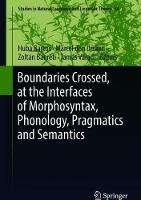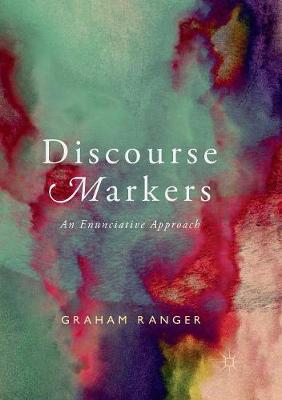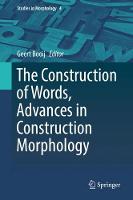Boundaries Crossed, at the Interfaces of Morphosyntax, Phonology, Pragmatics and Semantics
 -15%
portes grátis
-15%
portes grátis
Boundaries Crossed, at the Interfaces of Morphosyntax, Phonology, Pragmatics and Semantics
Bartos, Huba; den Dikken, Marcel; Varadi, Tamas; Banreti, Zoltan
Springer International Publishing AG
07/2018
401
Dura
Inglês
9783319907093
15 a 20 dias
6339
Descrição não disponível.
Marcel den Dikken: Introduction.- Part I: The lexicon and morphophonology.- Zoltan Banreti: Lexical recursion in aphasia: Case studies.- Ferenc Kiefer & Boglarka Nemeth: Aspectual constraints on noun incorporation in Hungarian.- Karoly Bibok: Instrument-subject alternation from a lexical-pragmatic perspective.- Marianne Bakro-Nagy: Mansi loanword phonology: A historical approach to the typology of repair strategies of Russian loanwords in Mansi.- Robert Vago: The epistemic/deontic suffix -hat/het in Hungarian: Derivational or inflectional?.- Part II: Morphology and syntax.- Katalin E. Kiss: Possessive agreement turned into a derivational suffix.- Veronika Hegedus: The rise of the modifier suffix -i with PPs.- Henk van Riemsdijk: Hybrid categories and the CIT.- Marta Ruda: Local operations deriving long-distance relations: Object agreement in Hungarian and the genitive of negation in Polish.- Marcel den Dikken: An integrated perspective on Hungarian nominal andverbal inflection.- Christina Tortora: Evidence for generalized verbal periphrasis in English.- Part III: Morphosyntax and meaning.- Julia Bacskai-Atkari: Marking finiteness and low peripheries.- Beata Gyuris: Ugye in Hungarian: Towards a unified analysis.- Laszlo Kalman: Neo-Lockean semantics.- Anna Szabolcsi: Strict and non-strict negative concord in Hungarian: A unified analysis.- Balazs Suranyi: Focus in focus.- Gabor Alberti & Judit Farkas: The relationship in Hungarian of animacy features to information-structural functions, degrees of referentiality and number.- Krisztina Szecsenyi: Control and the left periphery: The scope and information structure properties of Hungarian infinitival clauses with nominative, dative and covert subjects.- Part IV: Morphosyntax and phonology.- Jaklin Kornfilt: Sounds are not equal, nor is all silence.- Michael Brody: Two advantages of precedence syntax.- Aniko Liptak: Dissecting adpositional particle constructions: Remarks from ellipsis.- Tim Mckinnon, Gabriella Hermon, Yanti & Peter Cole: From phonology to syntax: Insights from Jangkat Malay.- Judit Gervain: Gateway to language: The perception of prosody at birth.- Irene Vogel: The morpho-syntax-phonology interface in complex compounds
Este título pertence ao(s) assunto(s) indicados(s). Para ver outros títulos clique no assunto desejado.
Historical linguistics;Pragmatics, information structure;Noun incorporation in Hungarian;Neo-Lockean semantics;Hungarian hybrid negative concord system;Object agreement in Hungarian;The genitive of negation in Polish
Marcel den Dikken: Introduction.- Part I: The lexicon and morphophonology.- Zoltan Banreti: Lexical recursion in aphasia: Case studies.- Ferenc Kiefer & Boglarka Nemeth: Aspectual constraints on noun incorporation in Hungarian.- Karoly Bibok: Instrument-subject alternation from a lexical-pragmatic perspective.- Marianne Bakro-Nagy: Mansi loanword phonology: A historical approach to the typology of repair strategies of Russian loanwords in Mansi.- Robert Vago: The epistemic/deontic suffix -hat/het in Hungarian: Derivational or inflectional?.- Part II: Morphology and syntax.- Katalin E. Kiss: Possessive agreement turned into a derivational suffix.- Veronika Hegedus: The rise of the modifier suffix -i with PPs.- Henk van Riemsdijk: Hybrid categories and the CIT.- Marta Ruda: Local operations deriving long-distance relations: Object agreement in Hungarian and the genitive of negation in Polish.- Marcel den Dikken: An integrated perspective on Hungarian nominal andverbal inflection.- Christina Tortora: Evidence for generalized verbal periphrasis in English.- Part III: Morphosyntax and meaning.- Julia Bacskai-Atkari: Marking finiteness and low peripheries.- Beata Gyuris: Ugye in Hungarian: Towards a unified analysis.- Laszlo Kalman: Neo-Lockean semantics.- Anna Szabolcsi: Strict and non-strict negative concord in Hungarian: A unified analysis.- Balazs Suranyi: Focus in focus.- Gabor Alberti & Judit Farkas: The relationship in Hungarian of animacy features to information-structural functions, degrees of referentiality and number.- Krisztina Szecsenyi: Control and the left periphery: The scope and information structure properties of Hungarian infinitival clauses with nominative, dative and covert subjects.- Part IV: Morphosyntax and phonology.- Jaklin Kornfilt: Sounds are not equal, nor is all silence.- Michael Brody: Two advantages of precedence syntax.- Aniko Liptak: Dissecting adpositional particle constructions: Remarks from ellipsis.- Tim Mckinnon, Gabriella Hermon, Yanti & Peter Cole: From phonology to syntax: Insights from Jangkat Malay.- Judit Gervain: Gateway to language: The perception of prosody at birth.- Irene Vogel: The morpho-syntax-phonology interface in complex compounds
Este título pertence ao(s) assunto(s) indicados(s). Para ver outros títulos clique no assunto desejado.




